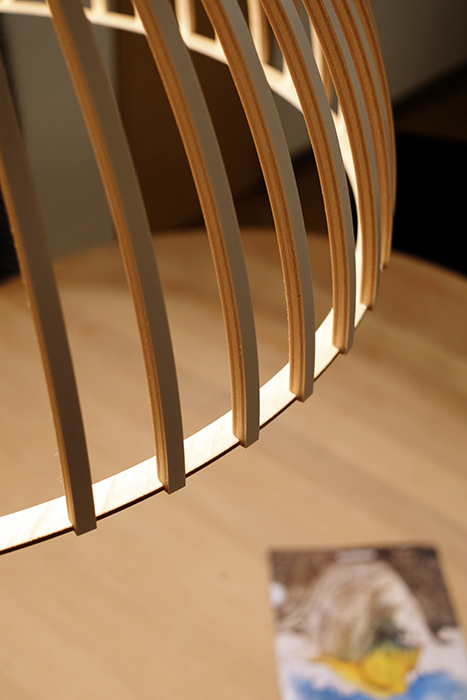プライウッドは合板、ベニヤ板のこと。
家具や建材など(もちろん照明にも)、さまざまな用途に使われている身近な材料です。合板はローラー台で木を裁断して作られるため、1本の木を無駄なく利用できるというメリットがあります。

ところで、初めてベニヤ板製造のパテントが申請されたのは1797年と随分昔のこと(イギリス人のSamuel Benthamによってでした)。 1850年頃にはスウェーデン人のエンジニア Immanuel Nobelが、数枚の薄板を重ねて強度を増せば工業的な用途で使うことができると考え、回転式の製造機械を発明。1920年代にはこの技術がアメリカへと伝わり、4×8フィート(1.2×2.4m) の標準サイズの合板が建材として普及していったそうです。
1930年代に近代的なデザインを追求した建築家やデザイナーたち(例えばアルヴァ・アールトなど)は、構造的かつ美的な観点からプライウッドを使いました。しかしプライウッドは安っぽいインテリア素材と思われることがあり、広く一般化したのは50年代に入ってからでした(ヴィクトリアアルバート美術館の説明から)。
プライウッドは狂いも少なく強度のあるエコな素材なのですが、かつては安っぽいイメージもあったようですね。
***
Plywood is a sheet material manufactured from thin layers or “plies” of wood veneer. Now plywood are used for many puorpuses, making furniture, as building materials and also for lightings too!
In 1797 Samuel Bentham applied for patents covering several machines to produce veneers.About fifty years later Immanuel Nobel realized that several thinner layers of wood bonded together would be stronger than one single thick layer of wood understanding the industrial potential of laminated wood he invented the rotary lathe.
Plywood was introduced into the United States in 1865 and industrial production started shortly after. In 1928, the first standard-sized 4 ft by 8 ft (1.2 m by 2.4 m) plywood sheets were introduced in the United States for use as a general building material.
1930s modernists such as Alvar Aalto exploited plywood for its structural and aesthetic qualities. But it was often seen as a cheap, inferior material and only became acceptable to the wider market in the 1950s.
***
